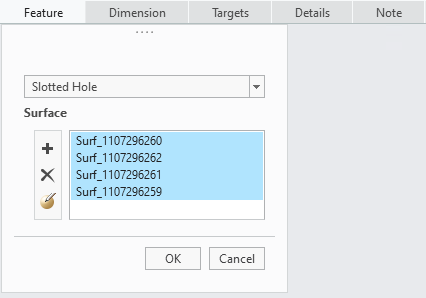Edit/Redefine Feature

1. Feature Type — Shows the feature type.
2. Add Surface Button — Add one or more surfaces to the feature by selecting from the CAD model.
3. Remove Surface Button — Remove the selected surface in the Surface List from feature.
4. Redefine Button — Redefine the feature by selecting surfaces from the CAD model.
5. Surface List — List all of the CAD surfaces that are referenced by the feature.
The surface list shows a list of all of the surfaces that are referenced by the feature. When you click on an item in the list, the corresponding surface is highlighted on the CAD model.
Keep in mind that adding or removing surfaces to a feature may change the feature type (see Feature Descriptions) and may affect the applicable geometric characteristic symbols for that feature. For example, suppose you have a Revolved Group feature constrained with circular runout. If you add a surface, the feature type may change to General Group (depending on the surface type and orientation). Since circular runout cannot be applied to a General Group feature, that geometric characteristic symbol will no longer be applicable to the feature, resulting in an advisor error message.
The following rules apply while editing the geometry references of a feature:
• For Multi-Surface (non-size) Features:
◦ Cannot edit the sub-features separately.
◦ Cannot edit the geometry references of the main feature if any of the sub-features have been set as a datum feature.
◦ When editing the main feature:
▪ All geometric tolerances that applied to the sub-features are deleted and any size dimensions are reset to default tolerances.
▪ The resulting feature may have a different number of degrees of variance from the original feature.
• Multi-Surface Features of Size:
◦ Cannot edit the sub-features separately.
• Features that are members of a pattern may not be edited.
• For a feature that has been set as a datum feature:
◦ The resulting feature has a similar datum type (e.g., planar or axial) as the original feature (e.g., a hole may not be redefined to be a planar surface if the hole is set as a datum feature).